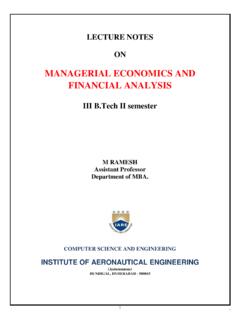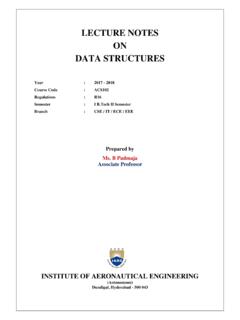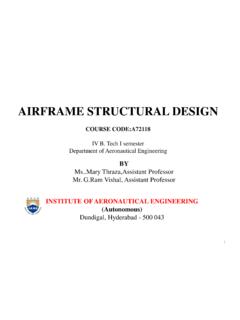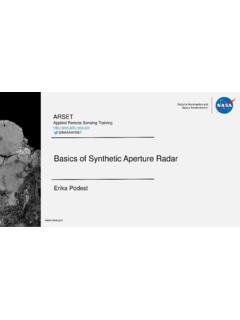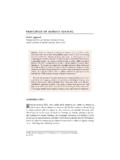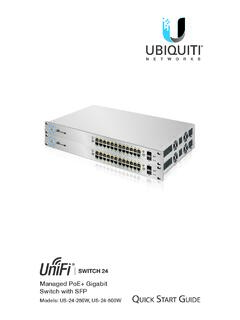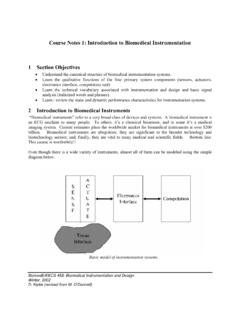Transcription of REMOTE SENSING AND GIS (A70140) - Welcome to IARE
1 1 LECTURE NOTES ON REMOTE SENSING AND GIS (A70140) IV B. Tech I Semester (JNTUH-R15) By Mr. Y. Ravi Kumar Assistant Professor DEPARTMENT OF CIVIL ENGINEERING INSTITUTE OF AERONAUTICAL ENGINEERING (Autonomous) DUNDIGAL, HYDERABAD - 500 043 2 UNIT-1 PHOTOGRAMMETRY Photogrammetry is the science of making measurements from photographs, especially for recovering the exact positions of surface points. Moreover, it may be used to recover the motion pathways of designated reference points located on any moving object, on its components and in the immediately adjacent environment. Photogrammetry may employ high-speed imaging and REMOTE SENSING in order to detect, measure and record complex 2-D and 3-D motion fields (see also sonar, radar, lidar etc.). Photogrammetry feeds the measurements from REMOTE SENSING and the results of imagery analysis into computational models in an attempt to successively estimate, with increasing accuracy, the actual, 3-D relative motions within the researched field.
2 Low altitude aerial photograph for use in Photogrammetry - Location Three Arch Bay, Laguna Beach CA. Its applications include satellite tracking of the relative positioning alterations in all Earth environments ( tectonic motions etc.), the research on the swimming of fish, of bird or insect flight, other relative motion processes ( International Society for Photogrammetry and REMOTE SENSING ). The quantitative results of photogrammetry are then used to guide and match the results of computational models of the natural systems, thus helping to invalidate or confirm new theories, to design novel vehicles or new methods for predicting or/and controlling the consequences of earthquakes, tsunamis, any other weather types, or used to understand the flow of fluids next to solid structures and many other processes.
3 Photogrammetry is as old as modern photography, can be dated to the mid-nineteenth century, and its detection component has been emerging from radiolocation, multilateration 3 and radiometry while its 3-D positioning estimative component (based on modeling) employs methods related to triangulation, trilateration and multidimensional scaling. In the simplest example, the distance between two points that lie on a plane parallel to the photographic image plane can be determined by measuring their distance on the image, if the scale (s) of the image is known. This is done by multiplying the measured distance by 1/s. Algorithms for photogrammetry typically attempt to minimize the sum of the squares of errors over the coordinates and relative displacements of the reference points. This minimization is known as bundle adjustment and is often performed using the Levenberg Marquardt algorithm.
4 BASIC CONCEPTS OF REMOTE SENSING 1. Introduction REMOTE SENSING is an art and science of obtaining information about an object or feature without physically coming in contact with that object or feature. Humans apply REMOTE SENSING in their day-to-day business, through vision, hearing and sense of smell. The data collected can be of many forms: variations in acoustic wave distributions ( , sonar), variations in force distributions ( , gravity meter), variations in electromagnetic energy distributions ( , eye) etc. These remotely collected data through various sensors may be analysed to obtain information about the objects or features under investigation. In this course we will deal with REMOTE SENSING through electromagnetic energy sensors only. Thus, REMOTE SENSING is the process of inferring surface parameters from measurements of the electromagnetic radiation (EMR) from the Earth s surface.
5 This EMR can either be reflected or emitted from the Earth s surface. In other words, REMOTE SENSING is detecting and measuring electromagnetic (EM) energy emanating or reflected from distant objects made of various materials, so that we can identify and categorize these objects by class or type, substance and spatial distribution [American Society of Photogrammetry, 1975]. REMOTE SENSING provides a means of observing large areas at finer spatial and temporal frequencies. It finds extensive applications in civil engineering including watershed studies, hydrological states and fluxes simulation, hydrological modelling, disaster management services such as flood and drought warning and monitoring, damage assessment in case of natural calamities, environmental monitoring, urban planning etc. 4 Basic concepts of REMOTE SENSING are introduced below.
6 2. Electromagnetic Energy Electromagnetic energy or electromagnetic radiation (EMR) is the energy propagated in the form of an advancing interaction between electric and magnetic fields (Sabbins, 1978). It travels with the velocity of light. Visible light, ultraviolet rays, infrared rays, heat, radio waves, X-rays all are different forms of electro-magnetic energy. Electro-magnetic energy (E) can be expressed either in terms of frequency (f) or wave length ( ) of radiation as E = h c f or h c / where h is Planck's constant ( x 10-34 Joules-sec), c is a constant that expresses the celerity or speed of light (3 x 108 m/sec), f is frequency expressed in Hertz and is the wavelength expressed in micro meters (1 m = 10-6 m). As can be observed from equation (1), shorter wavelengths have higher energy content and longer wavelengths have lower energy content.
7 Distribution of the continuum of energy can be plotted as a function of wavelength (or frequency) and is known as the EMR spectrum All matters reflect, emit or radiate a range of electromagnetic energy, depending upon the material characteristics. In REMOTE SENSING , it is the measurement of electromagnetic radiation reflected or emitted from an object, is the used to identify the target and to infer its properties. 3. Principles of REMOTE SENSING Different objects reflect or emit different amounts of energy in different bands of the electromagnetic spectrum. The amount of energy reflected or emitted depends on the properties of both the material and the incident energy (angle of incidence, intensity and wavelength). Detection and discrimination of objects or surface features is done through the uniqueness of the reflected or emitted electromagnetic radiation from the object.
8 A device to detect this reflected or emitted electro-magnetic radiation from an object is called a sensor ( , cameras and scanners). A vehicle used to carry the sensor is called a platform ( , aircrafts and satellites). 5 Main stages in REMOTE SENSING are the following. A. Emission of electromagnetic radiation 1. The Sun or an EMR source located on the platform B. Transmission of energy from the source to the object 2. Absorption and scattering of the EMR while transmission C. Interaction of EMR with the object and subsequent reflection and emission 3. D. Transmission of energy from the object to the sensor E. Recording of energy by the sensor 4. Photographic or non-photographic sensors F. Transmission of the recorded information to the ground station G. Processing of the data into digital or hard copy image H. Analysis of data 4. passive / Active REMOTE SENSING Depending on the source of electromagnetic energy, REMOTE SENSING can be classified as passive or active REMOTE SENSING .
9 In the case of passive REMOTE SENSING , source of energy is that naturally available such as the Sun. Most of the REMOTE SENSING systems work in passive mode using solar energy as the source of EMR. Solar energy reflected by the targets at specific wavelength bands are recorded using sensors on board air-borne or space borne platforms. In order to ensure ample signal strength received at the sensor, wavelength / energy bands capable of traversing through the atmosphere, without significant loss through atmospheric interactions, are generally used in REMOTE SENSING Any object which is at a temperature above 0o K (Kelvin) emits some radiation, which is approximately proportional to the fourth power of the temperature of the object. Thus the Earth also emits some radiation since its ambient temperature is about 300o K.
10 passive sensors can also be used to measure the Earth s radiance but they are not very popular as the energy content is very low. In the case of active REMOTE SENSING , energy is generated and sent from the REMOTE SENSING platform towards the targets. The energy reflected back from the targets are recorded using sensors on board the REMOTE SENSING platform. Most of the microwave REMOTE SENSING is done through active REMOTE SENSING . 6 As a simple analogy, passive REMOTE SENSING is similar to taking a picture with an ordinary camera whereas active REMOTE SENSING is analogous to taking a picture with camera having built-in flash 5. REMOTE SENSING Platforms REMOTE SENSING platforms can be classified as follows, based on the elevation from the Earth s surface at which these platforms are placed. Ground level REMOTE SENSING , Ground level REMOTE sensors are very close to the ground.

